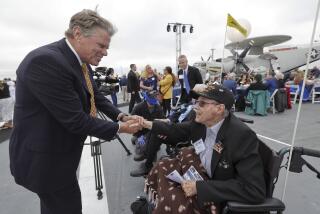Final Splash for Mighty Mo : Historic Battleship Hosts 30,000 Before Retirement
- Share via
To see her now, teakwood decks smooth and sturdy, her huge hull and bridges a spotless haze gray, it’s hard to believe that the battleship Missouri was commissioned in 1944 and saw combat in World War II, Korea and the Persian Gulf.
Hard to believe, that is, unless one talks to some of the crew of the 58,000-ton battleship anchored at the Long Beach Naval Station.
“It sounds hokey, but it’s true,” Lt. Cmdr. T.L. McCreary said Sunday. “There is such a sense of history about the ship that the crew has always tended to stand a little straighter aboard the ship.
“They have always tended to work a little harder to preserve it in excellent condition.”
That hard work was evident over the weekend when a crowd exceeding 30,000 visited the Missouri during the last public tours of the ship before it is decommissioned and mothballed at Puget Sound Naval Shipyard in Bremerton, Wash.
Waiting in line for up to three hours, the men, women and children visiting the vessel on Sunday spoke as much of the Missouri’s well-cared-for appearance as its storied past.
“I’ve never seen anything like this,” said Len Mendrick, a 41-year-old contractor from Fontana, who was accompanied by his two young daughters, and a friend, Steve Crane, 43, of Rialto.
Touring the ship’s 887-foot deck, Carl Huddleston, 40, of Burbank marveled at the ship’s condition and her sense of history.
“Ever since I was a kid, I heard about the Missouri. I had a model of it,” he said. “And to be walking on planks where history was made; I mean (Gen. Douglas) MacArthur walked this deck . . . there is just a sense of awe.”
Built in 1944 at the Brooklyn Naval Shipyard, the Missouri was the fourth ship and the second battleship to carry the name of the “Show Me” state. And if the New Jersey is the nation’s most decorated battleship, the Missouri--nicknamed Mighty Mo--is its most historic.
After service in the battles of Iwo Jima and Okinawa during World War II, the Missouri was the site of the signing of the formal end of the war with Japan on Sept. 2, 1945. That ceremony, as photographs aboard the ship show, included MacArthur, Adm. Chester Nimitz and other famed military strategists of the war.
Between 1950 and 1953, the Missouri was called into action for the Korean War before being decommissioned and mothballed in 1955.
In 1986, the ship was recommissioned and set out on an around-the-world shakedown cruise--the first battleship to do so since President Theodore Roosevelt’s so-called “Great White Fleet” of 1907.
A year later, the Missouri sailed to the Persian Gulf to help safeguard shipping operations near the Strait of Hormuz. Then, last November, it was sent again to the Persian Gulf, where it launched Tomahawk cruise missiles and its 16-inch guns shelled Iraqi bunkers in Kuwait for 60 hours during Operation Desert Storm.
Now, two months after returning from the Gulf, the Missouri’s mammoth guns are capped by wooden plugs and the ship seems more of a floating museum than a pivotal player in both wartime action and peace accords.
Later this month, the Missouri will sail to Seattle, and on Dec. 7 it is scheduled to be in Pearl Harbor for the 50th anniversary of that fateful start of America’s entry into World War II.
After that, the vessel will be decommissioned and its crew will be reassigned.
For many, said Ensign Peter Riehl, 23, that reassignment follows what he described as a “dream assignment” aboard the Missouri.
“You don’t have too many sailors in this day and age who can say they were aboard a battleship” like the Missouri, Riehl said, as he watched a steady procession of visitors marvel at the vessel’s huge deck and guns.
And while its crew will miss the Missouri, its decommissioning may not be an event entirely to mourn. After all, as its current crew knows, the Missouri was mothballed before. And a graceful retirement is preferable to another fate, said McCreary, who has been aboard the Missouri since 1987.
“If they bring it back for a specific purpose, to increase the size of the fleet, for example, that’s one thing,” McCreary said. “But if you are forced to bring it back just for war . . . you would prefer it not being brought back.
“Nobody wants to go to war, especially those who have been in it,” he said.
More to Read
Sign up for Essential California
The most important California stories and recommendations in your inbox every morning.
You may occasionally receive promotional content from the Los Angeles Times.













